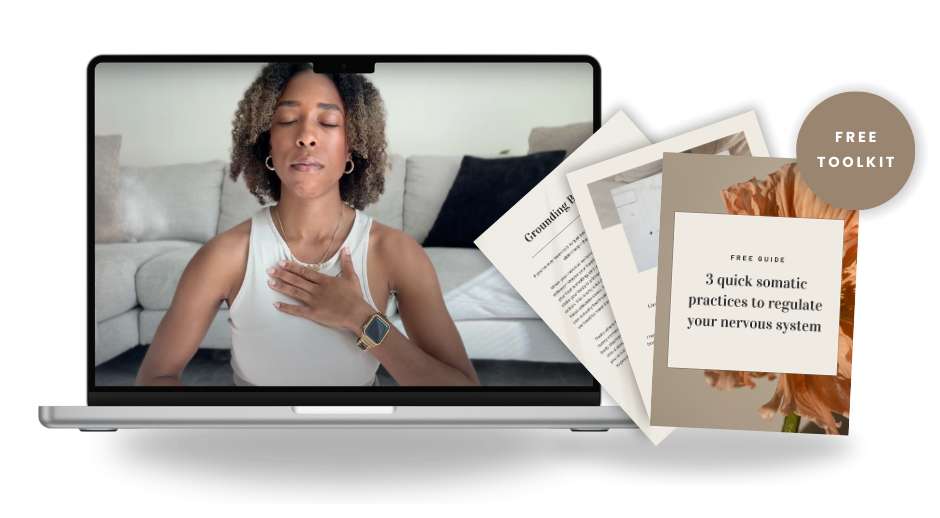Relational Gestalt Therapy in Los Angeles, California
In case you’re new here, I’m Chelsey Reese, and I specialize in helping women of color release stored trauma, regulate their nervous systems, and break free from chronic stress cycles. In my somatic therapy service , I provide a safe, supportive space where you can reconnect with your body, regulate your nervous system, and release stored tension. If you’re looking for a therapist who utilizes a relational therapy approach, you’ve come to the right place.
Many women move through life prioritizing others, suppressing their own needs, and struggling to express their emotions authentically. Somatic therapy and relational gestalt therapy offer a pathway to release past trauma, restore emotional balance, and cultivate deeper, more fulfilling relationships. Let’s explore how these approaches work and whether they’re the right fit for you.
What is relational gestalt therapy?
Relational gestalt therapy is a present-focused, experiential form of therapy that helps individuals process emotions, improve self-awareness, and foster authentic connections. Unlike traditional talk therapy, this approach integrates mind-body awareness, nervous system regulation, and relational healing to address deep-seated patterns of disconnection.
By exploring how past relationships and cultural conditioning have shaped your emotional responses, relational gestalt therapy allows you to break free from survival mode, develop emotional resilience, rewire the way you think about and relate to the world, and build relationships that feel safe and nourishing.
Most common symptoms of relational gestalt challenges:
- Feeling emotionally disconnected from yourself or others, even in close relationships.
- Struggling to express needs and boundaries due to fear of conflict or rejection.
- Repeating unhealthy relationship patterns in friendships, family, or romantic relationships.
- Experiencing chronic stress, anxiety, or tension in your body with no clear cause.
- Suppressing emotions to avoid discomfort, leading to emotional exhaustion.
How do I know if I need relational gestalt therapy?
Ask yourself:
- Do I avoid difficult conversations because I fear being too much or not enough?
- Have I been taught to prioritize others' needs over my own, leaving me drained?
- Do I find myself replaying past interactions, wondering what I should have said differently?
- Do I struggle to recognize or express what I truly feel in the moment?
- Have I been longing for deeper, more fulfilling relationships but don’t know where to start?
If any of these resonate, relational gestalt therapy can help you navigate these challenges with more clarity, confidence, and self-trust.
How I treat relational gestalt therapy in Los Angeles
At Power Through Process, my approach to relational gestalt therapy includes:
- Somatic awareness – Learning to tune into your body’s cues and nervous system responses.
- Emotional processing – Creating a safe space to express, feel, and move through emotions instead of suppressing them.
- Boundary-setting and self-trust – Practicing how to communicate your needs and trust yourself in relationships.
- Relational healing – Understanding how past experiences influence present relationships and breaking generational patterns.
We don’t just talk about your struggles—we engage with them in the present moment, helping you move through what’s been holding you back.
What topics can we talk about in relational gestalt therapy?
- Navigating people-pleasing and self-silencing
- Healing from past relationship wounds and attachment patterns
- Breaking free from cultural or generational conditioning
- Developing emotional regulation and nervous system safety
- Practicing boundaries and learning to take up space unapologetically
Ready to get started?
Awareness & Understanding
Identify how stress, self-silencing, and past conditioning affect your body and mind. Gain clarity on the patterns keeping you stuck and reconnect with your inner voice.
Nervous System Regulation
Learn somatic techniques to release tension, calm your nervous system, and create a sense of safety within, allowing you to navigate stress with greater ease.
Boundaries & Self-Trust
Develop the confidence to set boundaries without guilt, express your needs, and trust your intuition—so you can show up fully for yourself and others.
Relational gestalt therapy specialists in Los Angeles
I’m Chelsey Reese, a somatic and relational therapist specializing in helping women of color heal from emotional suppression, break free from survival mode, and build deeply fulfilling relationships. Through relational gestalt therapy, I guide my clients toward greater self-awareness, emotional balance, and the confidence to express their needs without fear. I understand the unique challenges of navigating relationships while carrying cultural expectations, past wounds, and patterns of self-silencing, and I’m passionate about helping you step into relationships that feel aligned, safe, and nourishing.
Tips & resources for coping with relational challenges:
- Practice self-check-ins – Take a moment to ask yourself, “What am I feeling right now?” without judgment.
- Notice body cues – Your body holds wisdom. Pay attention to sensations like tightness, heat, or a lump in your throat.
- Start small with boundaries – Try saying “Let me think about it” instead of immediately saying yes.
- Engage in self-compassion – Treat yourself with the same kindness you offer others.
- Surround yourself with supportive relationships – Healing doesn’t happen in isolation; seek spaces where you feel safe and valued.

Hello, I’m Chelsey Reese
Licensed Clinical Social Worker, Relational and Somatic Therapist, Certified Sound Healer, and 200HR Registered Yoga Teacher.
I help people cultivate self-awareness by reconnecting with their bodies, releasing trauma and stress, and fostering deeper connections. I believe true healing comes from processing lived experiences and letting go of what no longer serves us. Passionate about community and wellness, I create spaces for growth and restoration. When I’m not working with clients, you’ll find me tending to my plants, lost in a book, or hiking in nature.

Investment: starting at $150
Options include:
- I offer virtual therapy sessions for California residents. My rates start at $150 for a 50-minute session.
- If you're interested in wellness services such as yoga, sound baths, or corporate wellness programs, please inquire for a custom package and pricing in Los Angeles and Metro Atlanta areas.
- All offerings include personalized care, resources, and recommendations tailored to your healing journey.
Book your first session or inquire about wellness offerings
FAQ
What is the difference between early Gestalt therapy and relational Gestalt therapy?
Early Gestalt therapy focused primarily on individual awareness, self-exploration, and present-moment experiences to enhance personal growth. Relational Gestalt therapy, on the other hand, emphasizes how healing happens in connection with others. It explores attachment theory and examines how past relational patterns influence your current relationships, helping you develop deeper emotional awareness and healthier connections. And it values the therapeutic relationship between client and therapist. As a relational therapist I work collaboratively with clients and utilize empathy, attunement, and co-regulation to truly connect with clients.
What are the different types of Gestalt therapy?
Gestalt therapy has evolved into several approaches, including:
- Traditional Gestalt therapy – Focuses on present-moment awareness and self-expression.
- Relational Gestalt therapy – Centers on interpersonal relationships and how past experiences shape them.
- Somatic Gestalt therapy – Incorporates body awareness to process emotions and trauma.
- Experiential Gestalt therapy – Uses creative techniques such as role-playing or guided imagery to explore emotions.
What are some examples of relational Gestalt therapy techniques?
Relational Gestalt therapy can include practices such as:
- Dialogues & role-playing – Encouraging open conversations between different parts of yourself or with imagined people from your past.
- Somatic awareness – Paying attention to physical sensations and body cues that reveal suppressed emotions.
- Exploring relationship patterns – Identifying recurring themes in relationships and shifting unhealthy dynamics.
- Present-moment processing – Noticing emotions as they arise and exploring them within the therapy space.
What is Gestalt therapy used for?
Gestalt therapy is used to help people increase self-awareness, improve emotional regulation, and enhance interpersonal relationships. It is particularly effective for trauma healing, anxiety, depression, low self-esteem, and relationship difficulties, as it focuses on understanding how past experiences shape current thoughts, emotions, and behaviors.
Is Gestalt therapy better than CBT?
Both therapies are effective, but they serve different purposes. Cognitive Behavioral Therapy (CBT) focuses on changing thought patterns to influence behavior, while Gestalt therapy emphasizes emotional awareness, personal responsibility, and relational healing. If you're looking for a structured, goal-oriented approach, CBT may be more suitable. If you want to explore deep emotional patterns and improve relationships, Gestalt therapy may be the better fit.
